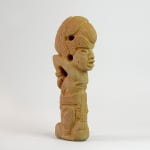Veracruz Stone Sculpture of a Bound Captive, 200 CE - 600 CE
34.9 x 6.3 x 15.2 cm
13 3/4 x 2 1/2 x 6 in
13 3/4 x 2 1/2 x 6 in
CK.0829
Further images
-
(View a larger image of thumbnail 1
)

-
(View a larger image of thumbnail 2
)

-
(View a larger image of thumbnail 3
)

-
(View a larger image of thumbnail 4
)

-
(View a larger image of thumbnail 5
)

-
(View a larger image of thumbnail 6
)

-
(View a larger image of thumbnail 7
)

-
(View a larger image of thumbnail 8
)

The Classic Veracruz cultures were small, tightly- packed city states, all governed by hereditary rulers, who sat at the top of highly stratified social structures. Economically, it was based upon...
The Classic Veracruz cultures were small, tightly- packed city states, all governed by hereditary rulers, who sat at the top of highly stratified social structures. Economically, it was based upon slash and burn agricultural techniques, supplemented by exploitation of marine resources, as well as hunting. The culture was fuelled by long- distance trade networks that ran throughout Mesoamerica, as evidenced by the spread of luxury items and exotic goods. In this they strongly resemble the Olmecs, who preceded them and to whom they owed a considerable cultural and artistic debt. Religion was based upon the Olmec “earth monster”, as well as a death god who has been likened to Mictlantecuhtli, a deity worshipped by their cultural neighbour, the Aztecs. Like the Aztecs, they were obsessed with death, sacrifice and the Mesoamerican ballgame, another cultural bequest from the Olmecs. There are accounts stating that the losing team was sacrificed as an offering to the gods; other chroniclers suggest that it might have been used as a substitute for warfare. As a result their iconography is somewhat sanguineous – with decapitations, blood-letting and bound prisoners common themes – surrounded by extensive and convoluted banded scrolls that can be seen both on monumental architecture and on mobile art. A defining characteristic of the Classic Veracruz culture is the presence of stone ballgame gear: yokes, hachas, and palmas. Yokes are U- shaped stones worn about the waist of a ballplayer, while the hachas and palmas sit upon the yoke. These were probably worn ceremonially by the victors; the actual pieces were probably made of wood and leather. Interestingly, while hachas and yokes are found throughout the range, the palmas seem peculiar to what is today northern Veracruz.







